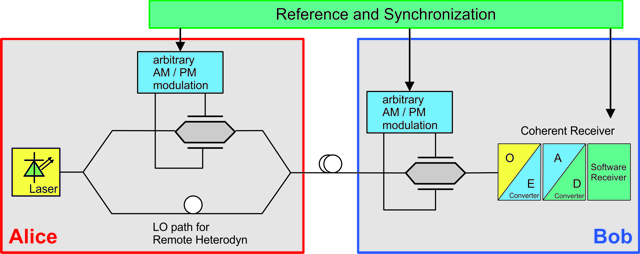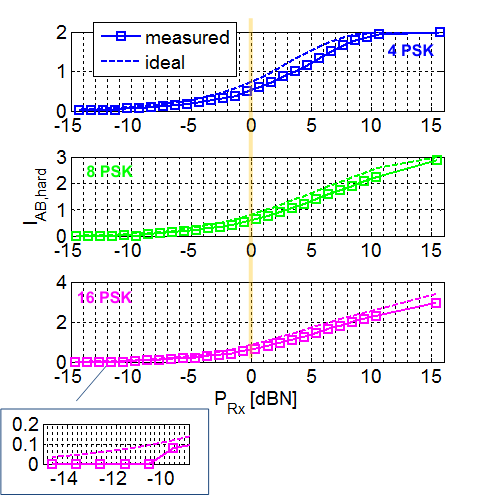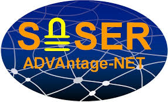Coherent systems for the generation of keys for secure Communication
Press release (1. Dez. 2015)
Trend setting research project ADVAntage-NET rated “excellent”
At the final review meeting in Meiningen the project ADVAntage-NET, part of the large Safe and Secure European Routing SASER research programme was rated “Excellent by an international team of experts. The goal of the SASER research programme is to provide the scientific, technical, and technological concepts and solutions for secure transport networks in the 2020 time frame (http://projects.celticplus.eu/saser/) Link wird in einem neuen Fenster geöffnet). The researches came from ADVA optical networking (technical lead), Fraunhofer Heinrich Hertz Institute, VPIphotonics and partners like Helmut-Schmidt-University Hamburg, TU Dortmund, Christian-Albrechts-University Kiel and University Ulm.
Part of ADVAntage-NET within the frame program SASER (Safe and Secure European Router)
The provision of reliable and secure optical communication paths is becoming increasingly important in the information era and is of great national economic interest. It allows people to achieve secure communications between different places without worries of information leakage. The examination of the applicability of methods and findings that are so far gained mainly in basic research, for the design of next generation optical communication systems is important.
Introduction
Secure communication over public channels is essential for the modern information society. Fundamental aspects of quantum mechanics are used to guarantee the secure communication. Quantum key distribution enables the two remote parties (often called Alice and Bob) to grow a shared random secret key known only to them, and which they can use for unconditionally secure communication over a certain distance. An important and unique property of quantum key distribution is the ability of the two communicating users to detect the presence of any third party (Eve) trying to gain knowledge of the key. A third party trying to eavesdrop on the key must in some way measure the quantum states in the quantum channel, thus introducing detectable anomalies. A communication system can be implemented which detects eavesdropping. After two steps of interactive reconciliation, error correction and privacy amplification via the classical channel a key can be generated from the remaining raw key material. If the level of eavesdropping is below a certain threshold, a key can be produced that is guaranteed to be secure (i.e. Alice and Bob have an information advantage over Eve), otherwise no secure key is possible and the communication is aborted. State of the art systems and protocols can be found at:
https://en.wikipedia.org/wiki/Quantum_key_distribution
Within the project our task was to investigate coherent communication systems, which are compatible with conventional optical communication technology. Our work is a step towards practical implementations of quantum key distribution with state-of-the-art security based solely on telecom components and modern methods of digital signal processing. The estimation of the achievable security represents a major result.
Basic structure
Optical coherent receivers require a strong a coherent local oscillator (LO) signal because the product of Signal and LO is detected and we can have a noise free gain in the receiver. There are two possibilities for the location of the LO in the system:
- One laser is used in the system and part of its output signal is used as LO. The LO is fed throughout the whole fiber system (see figure below). The advantage is the relaxed requirement on the coherence of the laser radiation. One disadvantage is the required power of the laser is determined by the optical losses in the system.
- A second laser is located at the receiver site like in conventional coherent communication systems. In this case signal and LO have their own coherence properties due to the laser linewidth. In modern optical coherent communication system the two lasers are free running. The influence of the lasers phase noise and of the frequency offset can be compensated with methods of digital signal processing in the receiver.
1. REMOTE HETERODYNE
In the figure we can see a remote heterodyne system. Faint M- PSK modulated laser pulses are used. The information is coded on the quantum states (red) transmitted through the fiber channel, measured and decided at the receiver.

In the first realization the local oscillator propagates together with the quantum signal in the same fiber. The LO is time- and polarization multiplexed.

2. “local” local oscillator
In our advanced system the free running LO is added at the receiver site. After the heterodyne detection and some digital signal processing we get the decided classical information.

The combined linewidth of the two lasers is approx. 200 kHz. The transmission rate is around 40 MBaud. For the evaluation of the performance of the system the mutual information between Alice and Bob is calculated. Due to the imperfection of the receiver we get a 2 dB penalty. The lowest power in the results presented here is around 0.1 photons/symbol. The theoretical and experimental results are given for 4 to 16 PSK. The x-axis gives the number of photons per symbol in a logarithmic scale, i.e. 0 dB represents 1 photon/symbol. For larger amounts of photons the number of bit/symbol is 2,3 and 4 as expected for classical communication.

Persons involved in this project:
Dipl.-Wirtsch.- Ing. S. Kleis , M.Sc. M. Rückmann , Univ.-Prof. Dr.-Ing. C. G. Schäffer
Letzte Änderung: 9. October 2017


